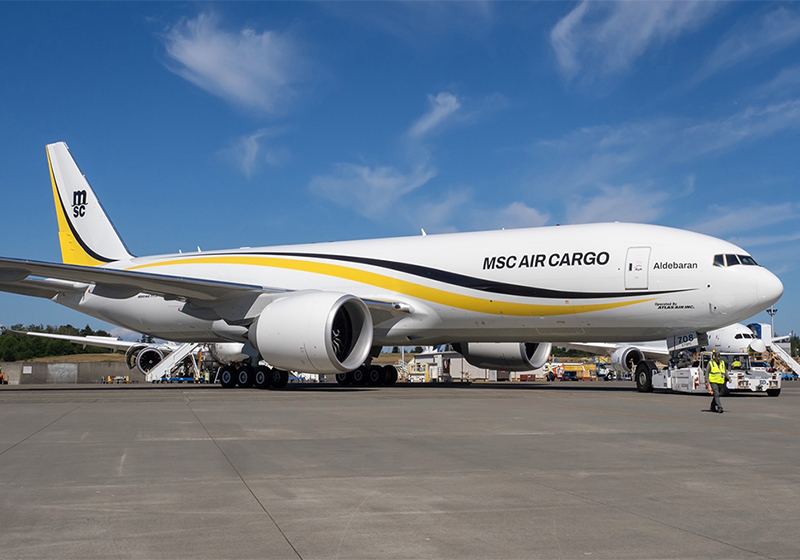Boeing 777-200F
Seats
200
Maximum Range (nm)
4895
ICAO Code
B77L

Boeing 777-200F
Introduction
The Boeing 777-200F is a long-range, high-capacity twin-engine freighter aircraft developed from the successful Boeing 777 passenger series. Entering service in 2009, it is the largest and most capable twin-engine cargo jet in the world. Designed to meet the demanding requirements of global freight operations, the 777-200F offers unmatched fuel efficiency, payload capacity, and range, making it a favorite among major cargo airlines and long-haul logistics providers worldwide.
Specification of Boeing 777-200F
Manufacturer: Boeing Commercial Airplanes (USA)
Model: Boeing 777-200F
Crew: 2 (pilot and co-pilot)
Cargo Capacity: Up to 102 metric tonnes (224,900 lbs)
Engines: 2 × General Electric GE90-110B1L high-bypass turbofan engines
Length: 63.7 m (209 ft 1 in)
Wingspan: 64.8 m (212 ft 7 in)
Height: 18.6 m (61 ft 0 in)
Maximum Takeoff Weight (MTOW): 347,450 kg (766,800 lbs)
Main Deck Door: Large forward fuselage cargo door (3.72 × 3.05 m)
Performance and Range of Boeing 777-200F
Engineered for intercontinental hauls, the Boeing 777-200F offers exceptional range and performance:
Cruise Speed: 907 km/h (490 knots / Mach 0.84)
Maximum Speed: Mach 0.89
Maximum Range: 9,070 km (4,900 nautical miles) with full payload
Fuel Capacity: Approx. 181,280 liters (47,890 US gallons)
Service Ceiling: 43,100 ft
Takeoff Distance: Approx. 2,450 m (8,038 ft)
This allows nonstop operation on long international routes such as Hong Kong–Los Angeles or Frankfurt–Dubai.
Cabin Comfort and Interior of Boeing 777-200F
As a freighter aircraft, the Boeing 777-200F has a purpose-built cargo interior:
Main Deck Volume: 518 m³ (18,200 ft³)
Lower Hold Volume: 160 m³ (5,638 ft³)
Unit Load Device (ULD) Capacity:
Main Deck: 27 standard 96" x 125" pallets
Lower Holds: 10 pallets + 2 smaller containersTemperature Control: Separate zones for temperature-sensitive cargo (e.g., pharmaceuticals, perishables)
Special Features: Reinforced floor, cargo handling system with powered rollers, smoke detection, and fire suppression systems
The aircraft can accommodate oversized, hazardous, time-sensitive, and high-value cargo with ease.
Avionics and Technology of Boeing 777-200F
The Boeing 777-200F features an advanced avionics suite identical to the Boeing 777 passenger variants:
Cockpit: Two-crew glass cockpit with fly-by-wire controls
Avionics Suite: Honeywell digital flight control system
Navigation & Communication: Dual GPS, FMS, ACARS, Satcom, TCAS II, and weather radar
Autopilot & Systems: Fully integrated with autoland, VNAV/LNAV, and ETOPS-approved systems
Safety Features: Redundant systems, fault tolerance, and modern alerting systems for cargo integrity and system health
Its cockpit commonality with other Boeing widebodies reduces training and crew transition costs.
Operational Advantages of Boeing 777-200F
The Boeing 777-200F delivers superior economics and versatility in cargo operations:
Twin-Engine Efficiency: Lower fuel and maintenance costs compared to trijets or four-engine freighters
Payload-to-Range Flexibility: Maximum revenue-generating capacity without sacrificing range
Global Access: Meets ICAO and ETOPS regulations for oceanic and remote airspace operations
Environmentally Friendly: Quieter and lower emissions than older freighters like MD-11F or 747-400F
Reliability: Among the highest dispatch reliability rates in the long-haul freighter segment
It is a preferred solution for express cargo, integrator networks, and transcontinental e-commerce freight.
Who Should Charter Boeing 777-200F
The Boeing 777-200F is ideal for:
Global Logistics Companies: Needing high-capacity, long-haul cargo movement
E-Commerce Platforms: Fast delivery of bulk shipments over intercontinental distances
Freight Forwarders: Supporting time-sensitive or specialized supply chain requirements
Government and Military Missions: Transporting equipment, supplies, or humanitarian aid
Pharma, Aerospace, and Automotive Industries: Moving temperature-sensitive, oversized, or critical components
It is especially valuable when cargo demand exceeds the capacity or range of narrow-body or regional freighters.
Charter Cost Estimates for Boeing 777-200F
As a heavy long-haul freighter, chartering the Boeing 777-200F comes with premium rates:
Hourly Charter Rate: $24,000 – $30,000 USD
Full Charter (Long-Haul 10+ Hour Flight): $250,000 – $350,000+ USD
Cost per Kilogram (Estimate): $1.00 – $1.50 USD (route and cargo dependent)
Rates may vary significantly depending on fuel prices, airport handling charges, and route complexity.
Conclusion
The Boeing 777-200F is a state-of-the-art long-range freighter that redefines global cargo capability. With exceptional fuel efficiency, industry-leading payload capacity, and the reliability of a modern twin-engine platform, it offers unmatched value for long-haul freight charters. Whether you are shipping time-critical cargo, high-value goods, or bulk freight across continents, the 777-200F delivers power, performance, and precision at scale.
